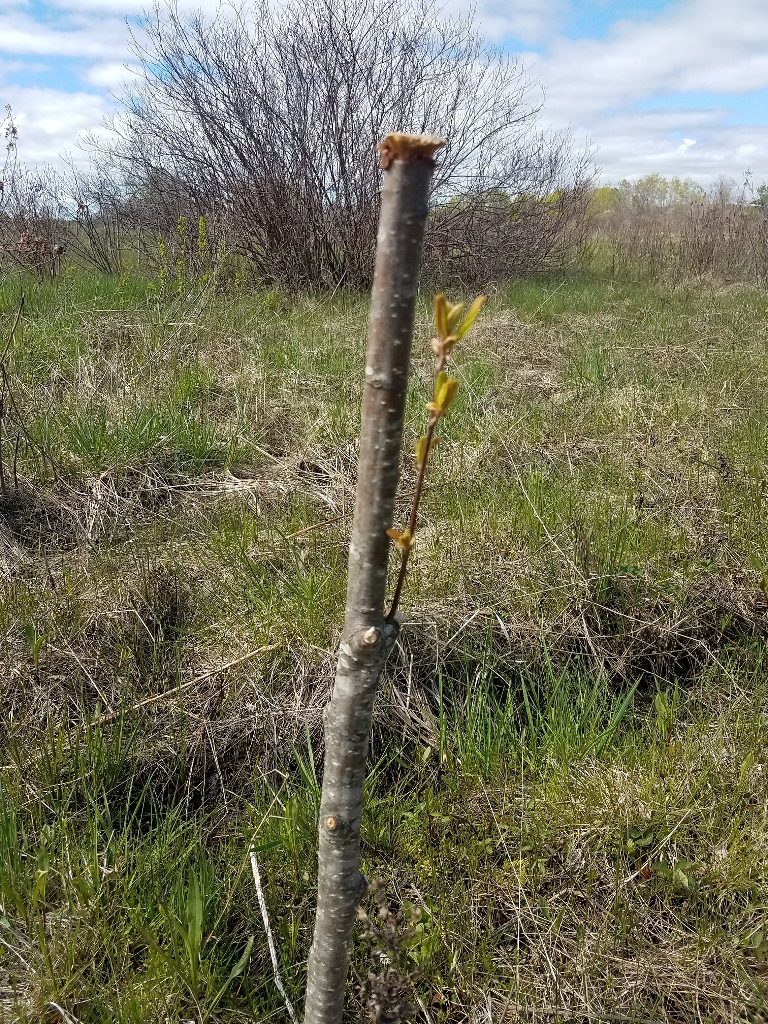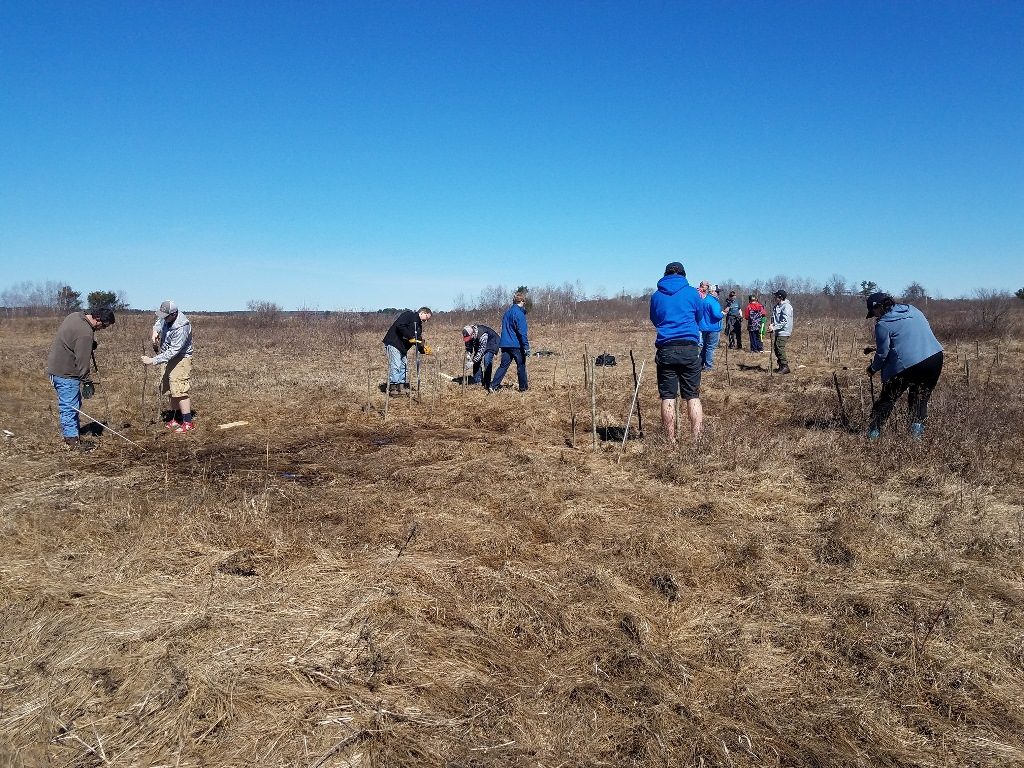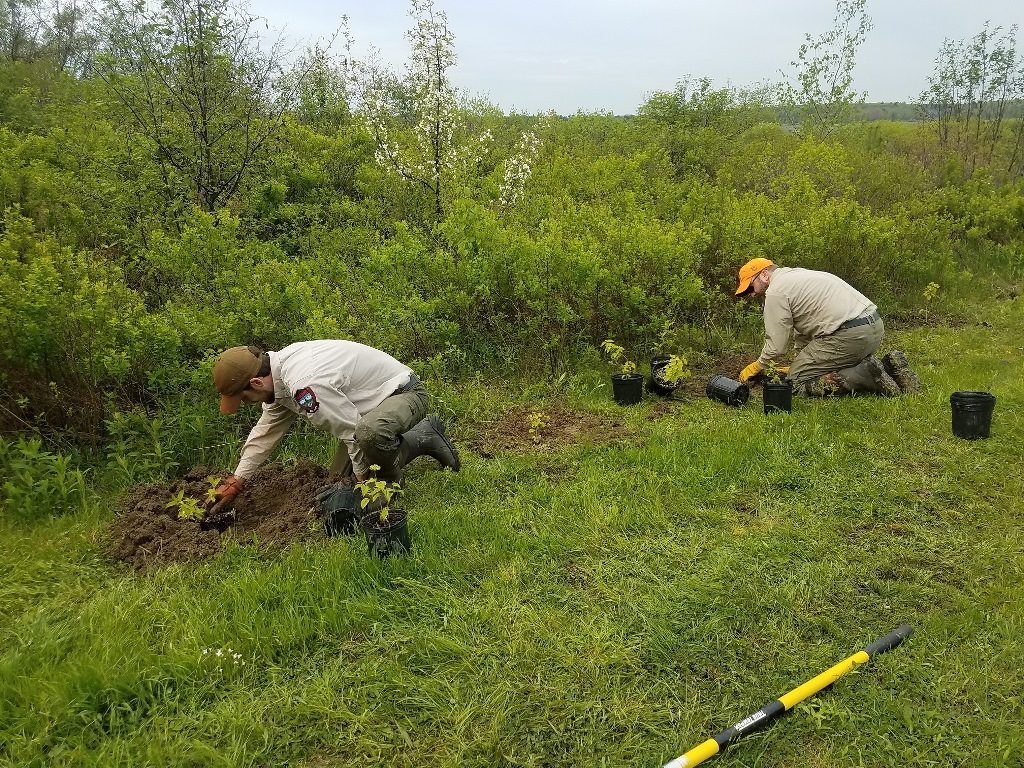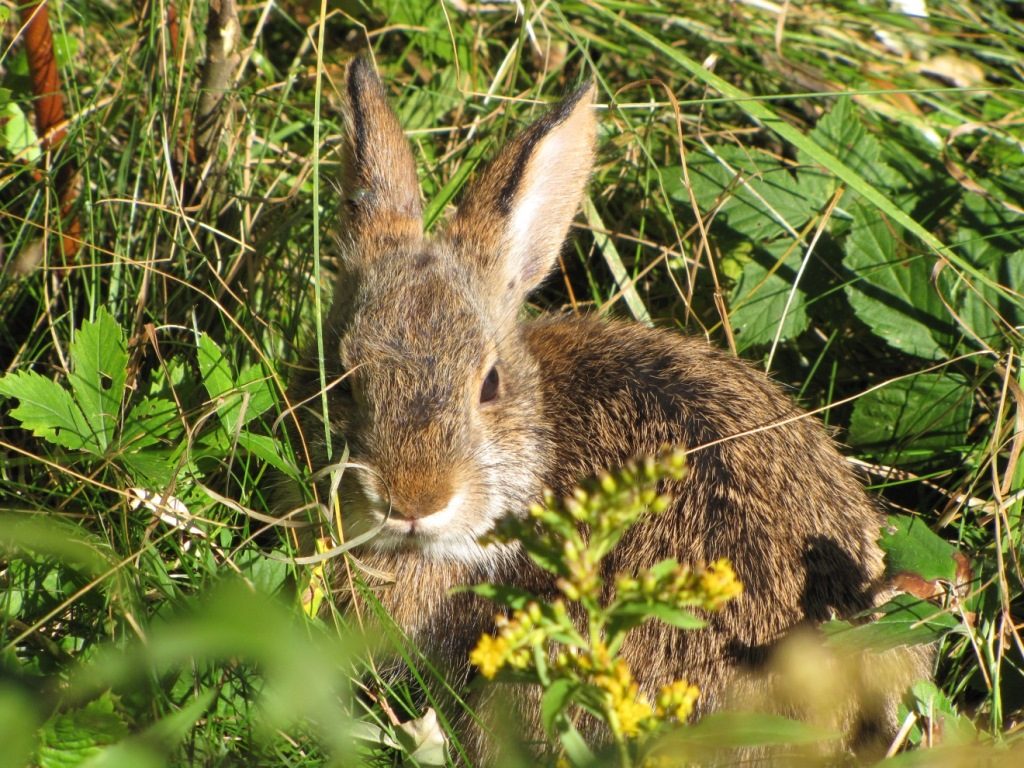August 9, 2017 at 4:53 pm
[caption id="attachment_2448" align="alignright" width="291"] Some native plants, such as alders, willows and dogwood, can be planted using the live stake method, which is basically a branchless stick. Here one branch bears budding alder leaves.[/caption]
By IFW Lands Management Biologist Eric Hoar
Scarborough Marsh Wildlife Management Area is a 3100 acre collection of parcels located in the towns of Scarborough and Old Orchard Beach. Scarborough Marsh is currently the focus of habitat enhancement for the state endangered New England cottontail rabbit. Portions of the area are represented by reverting farm fields which have regrown in pockets of dense shrub where as other areas remain grassy. With the help of several partners, Inland Fisheries and Wildlife engaged in a planting project for habitat enhancement for the improvement of both cover and food opportunities for NEC.
[caption id="attachment_2449" align="alignleft" width="430"]
Some native plants, such as alders, willows and dogwood, can be planted using the live stake method, which is basically a branchless stick. Here one branch bears budding alder leaves.[/caption]
By IFW Lands Management Biologist Eric Hoar
Scarborough Marsh Wildlife Management Area is a 3100 acre collection of parcels located in the towns of Scarborough and Old Orchard Beach. Scarborough Marsh is currently the focus of habitat enhancement for the state endangered New England cottontail rabbit. Portions of the area are represented by reverting farm fields which have regrown in pockets of dense shrub where as other areas remain grassy. With the help of several partners, Inland Fisheries and Wildlife engaged in a planting project for habitat enhancement for the improvement of both cover and food opportunities for NEC.
[caption id="attachment_2449" align="alignleft" width="430"] Boy Scout Troop 41 of Portland helped with the habitat enhancement work, including the planting of live stakes.[/caption]
Scarborough Marsh WMA is within a focal area for New England cottontail. NEC is Maine’s only native rabbit and has seen a significant decline in population over the last 50 years as habitat has been lost to development, abandoned fields have reverted to forest and creation of new habitat resulting from timber harvesting has declined. Unlike the snowshoe hare, NEC doesn’t turn white in the winter which makes it highly visible to predators (hawks, eagles, fox, coyote, bobcat, etc.) when snow covers the landscape. NEC requires a dense, shrubby habitat for both cover and concealment from predators, and browse for food. Habitat enhancement for NEC is a critical process to aid in survival of the species.
One element of habitat enhancement occurring this spring at Scarborough Marsh was the planting of “live stakes” – basically stem cuttings of shrub species which will grow despite lacking roots. Live stakes are literally a branchless, rootless stick. Few shrubs reliably grow this way but common native (as opposed to invasive) examples include alder, willow and dogwood. The live stake planting at Scarborough utilized alder. The stakes were harvested over the winter by Boy Scout Troop 41 of Portland, led by Aaron Hoekstra as a final project in his quest to become an Eagle Scout. The stakes were placed in cold storage until April and then planted by Aaron and the Troop to complete the project. Approximately 300 alder live stakes were planted in the span of three hours; excellent work by Aaron and the Troop.
[caption id="attachment_2451" align="alignright" width="424"]
Boy Scout Troop 41 of Portland helped with the habitat enhancement work, including the planting of live stakes.[/caption]
Scarborough Marsh WMA is within a focal area for New England cottontail. NEC is Maine’s only native rabbit and has seen a significant decline in population over the last 50 years as habitat has been lost to development, abandoned fields have reverted to forest and creation of new habitat resulting from timber harvesting has declined. Unlike the snowshoe hare, NEC doesn’t turn white in the winter which makes it highly visible to predators (hawks, eagles, fox, coyote, bobcat, etc.) when snow covers the landscape. NEC requires a dense, shrubby habitat for both cover and concealment from predators, and browse for food. Habitat enhancement for NEC is a critical process to aid in survival of the species.
One element of habitat enhancement occurring this spring at Scarborough Marsh was the planting of “live stakes” – basically stem cuttings of shrub species which will grow despite lacking roots. Live stakes are literally a branchless, rootless stick. Few shrubs reliably grow this way but common native (as opposed to invasive) examples include alder, willow and dogwood. The live stake planting at Scarborough utilized alder. The stakes were harvested over the winter by Boy Scout Troop 41 of Portland, led by Aaron Hoekstra as a final project in his quest to become an Eagle Scout. The stakes were placed in cold storage until April and then planted by Aaron and the Troop to complete the project. Approximately 300 alder live stakes were planted in the span of three hours; excellent work by Aaron and the Troop.
[caption id="attachment_2451" align="alignright" width="424"] IFW Biologists planted some shrubs which included arrowwood, swamp azalea, two species of native dogwood and grey birch.[/caption]
A second element of habitat enhancement currently underway at Scarborough Marsh is the planting of native shrub species. Last fall Inland Fisheries and Wildlife partnered with the Wildlife Management Institute and Rachel Carson National Wildlife Refuge to grow 2000-3000 shrubs for a planting as part of a plan developed specifically for the project by First Light Wildlife Habitats. The plan incorporates New England cottontail cover and food requirements, and soil types. A large portion of these shrubs will be planted this fall with the remainder to follow in the spring. Also, earlier this spring, Rachel Carson NWR offered several hundred additional shrubs remaining from projects they had engaged in the previous year. IF&W and Rachel Carson staff gathered at Scarborough in May and planted shrubs such as arrowwood, swamp azalea, two species of native dogwood and grey birch. Two members of the Maine Forest Service were also on hand as part of a training exercise and equipment deployment, and watered the shrubs following planting. They even assisted in the planting of a few shrubs. The result was 375 shrubs planted over the course of 7 hours by 10 members representing three organizations.
The New England cottontail restoration effort in Maine and New England is relatively young and, as with most habitat projects, is expected to take several years to develop. Both the live stakes and native shrubs will grow, increase in density and spread throughout the planting area resulting in more robust habitat. Adequate winter cover (no leaves) is the most limiting requirement for re-establishing a healthy rabbit population in Maine. The New England cottontail population is critically low. Populations require time to develop, through both reproduction and dispersal, even where habitat is enhance or created. Scarborough Marsh WMA is one of only a few wildlife management areas managed by Inland Fisheries and Wildlife within dispersal distance of NEC populations. It’s within a priority focus area and thus land managed in this area is highly valuable.
[caption id="attachment_2450" align="aligncenter" width="674"]
IFW Biologists planted some shrubs which included arrowwood, swamp azalea, two species of native dogwood and grey birch.[/caption]
A second element of habitat enhancement currently underway at Scarborough Marsh is the planting of native shrub species. Last fall Inland Fisheries and Wildlife partnered with the Wildlife Management Institute and Rachel Carson National Wildlife Refuge to grow 2000-3000 shrubs for a planting as part of a plan developed specifically for the project by First Light Wildlife Habitats. The plan incorporates New England cottontail cover and food requirements, and soil types. A large portion of these shrubs will be planted this fall with the remainder to follow in the spring. Also, earlier this spring, Rachel Carson NWR offered several hundred additional shrubs remaining from projects they had engaged in the previous year. IF&W and Rachel Carson staff gathered at Scarborough in May and planted shrubs such as arrowwood, swamp azalea, two species of native dogwood and grey birch. Two members of the Maine Forest Service were also on hand as part of a training exercise and equipment deployment, and watered the shrubs following planting. They even assisted in the planting of a few shrubs. The result was 375 shrubs planted over the course of 7 hours by 10 members representing three organizations.
The New England cottontail restoration effort in Maine and New England is relatively young and, as with most habitat projects, is expected to take several years to develop. Both the live stakes and native shrubs will grow, increase in density and spread throughout the planting area resulting in more robust habitat. Adequate winter cover (no leaves) is the most limiting requirement for re-establishing a healthy rabbit population in Maine. The New England cottontail population is critically low. Populations require time to develop, through both reproduction and dispersal, even where habitat is enhance or created. Scarborough Marsh WMA is one of only a few wildlife management areas managed by Inland Fisheries and Wildlife within dispersal distance of NEC populations. It’s within a priority focus area and thus land managed in this area is highly valuable.
[caption id="attachment_2450" align="aligncenter" width="674"] A New England Cottontail (Photo by Kelly Boland)[/caption]
A New England Cottontail (Photo by Kelly Boland)[/caption]
 Some native plants, such as alders, willows and dogwood, can be planted using the live stake method, which is basically a branchless stick. Here one branch bears budding alder leaves.[/caption]
By IFW Lands Management Biologist Eric Hoar
Scarborough Marsh Wildlife Management Area is a 3100 acre collection of parcels located in the towns of Scarborough and Old Orchard Beach. Scarborough Marsh is currently the focus of habitat enhancement for the state endangered New England cottontail rabbit. Portions of the area are represented by reverting farm fields which have regrown in pockets of dense shrub where as other areas remain grassy. With the help of several partners, Inland Fisheries and Wildlife engaged in a planting project for habitat enhancement for the improvement of both cover and food opportunities for NEC.
[caption id="attachment_2449" align="alignleft" width="430"]
Some native plants, such as alders, willows and dogwood, can be planted using the live stake method, which is basically a branchless stick. Here one branch bears budding alder leaves.[/caption]
By IFW Lands Management Biologist Eric Hoar
Scarborough Marsh Wildlife Management Area is a 3100 acre collection of parcels located in the towns of Scarborough and Old Orchard Beach. Scarborough Marsh is currently the focus of habitat enhancement for the state endangered New England cottontail rabbit. Portions of the area are represented by reverting farm fields which have regrown in pockets of dense shrub where as other areas remain grassy. With the help of several partners, Inland Fisheries and Wildlife engaged in a planting project for habitat enhancement for the improvement of both cover and food opportunities for NEC.
[caption id="attachment_2449" align="alignleft" width="430"] Boy Scout Troop 41 of Portland helped with the habitat enhancement work, including the planting of live stakes.[/caption]
Scarborough Marsh WMA is within a focal area for New England cottontail. NEC is Maine’s only native rabbit and has seen a significant decline in population over the last 50 years as habitat has been lost to development, abandoned fields have reverted to forest and creation of new habitat resulting from timber harvesting has declined. Unlike the snowshoe hare, NEC doesn’t turn white in the winter which makes it highly visible to predators (hawks, eagles, fox, coyote, bobcat, etc.) when snow covers the landscape. NEC requires a dense, shrubby habitat for both cover and concealment from predators, and browse for food. Habitat enhancement for NEC is a critical process to aid in survival of the species.
One element of habitat enhancement occurring this spring at Scarborough Marsh was the planting of “live stakes” – basically stem cuttings of shrub species which will grow despite lacking roots. Live stakes are literally a branchless, rootless stick. Few shrubs reliably grow this way but common native (as opposed to invasive) examples include alder, willow and dogwood. The live stake planting at Scarborough utilized alder. The stakes were harvested over the winter by Boy Scout Troop 41 of Portland, led by Aaron Hoekstra as a final project in his quest to become an Eagle Scout. The stakes were placed in cold storage until April and then planted by Aaron and the Troop to complete the project. Approximately 300 alder live stakes were planted in the span of three hours; excellent work by Aaron and the Troop.
[caption id="attachment_2451" align="alignright" width="424"]
Boy Scout Troop 41 of Portland helped with the habitat enhancement work, including the planting of live stakes.[/caption]
Scarborough Marsh WMA is within a focal area for New England cottontail. NEC is Maine’s only native rabbit and has seen a significant decline in population over the last 50 years as habitat has been lost to development, abandoned fields have reverted to forest and creation of new habitat resulting from timber harvesting has declined. Unlike the snowshoe hare, NEC doesn’t turn white in the winter which makes it highly visible to predators (hawks, eagles, fox, coyote, bobcat, etc.) when snow covers the landscape. NEC requires a dense, shrubby habitat for both cover and concealment from predators, and browse for food. Habitat enhancement for NEC is a critical process to aid in survival of the species.
One element of habitat enhancement occurring this spring at Scarborough Marsh was the planting of “live stakes” – basically stem cuttings of shrub species which will grow despite lacking roots. Live stakes are literally a branchless, rootless stick. Few shrubs reliably grow this way but common native (as opposed to invasive) examples include alder, willow and dogwood. The live stake planting at Scarborough utilized alder. The stakes were harvested over the winter by Boy Scout Troop 41 of Portland, led by Aaron Hoekstra as a final project in his quest to become an Eagle Scout. The stakes were placed in cold storage until April and then planted by Aaron and the Troop to complete the project. Approximately 300 alder live stakes were planted in the span of three hours; excellent work by Aaron and the Troop.
[caption id="attachment_2451" align="alignright" width="424"] IFW Biologists planted some shrubs which included arrowwood, swamp azalea, two species of native dogwood and grey birch.[/caption]
A second element of habitat enhancement currently underway at Scarborough Marsh is the planting of native shrub species. Last fall Inland Fisheries and Wildlife partnered with the Wildlife Management Institute and Rachel Carson National Wildlife Refuge to grow 2000-3000 shrubs for a planting as part of a plan developed specifically for the project by First Light Wildlife Habitats. The plan incorporates New England cottontail cover and food requirements, and soil types. A large portion of these shrubs will be planted this fall with the remainder to follow in the spring. Also, earlier this spring, Rachel Carson NWR offered several hundred additional shrubs remaining from projects they had engaged in the previous year. IF&W and Rachel Carson staff gathered at Scarborough in May and planted shrubs such as arrowwood, swamp azalea, two species of native dogwood and grey birch. Two members of the Maine Forest Service were also on hand as part of a training exercise and equipment deployment, and watered the shrubs following planting. They even assisted in the planting of a few shrubs. The result was 375 shrubs planted over the course of 7 hours by 10 members representing three organizations.
The New England cottontail restoration effort in Maine and New England is relatively young and, as with most habitat projects, is expected to take several years to develop. Both the live stakes and native shrubs will grow, increase in density and spread throughout the planting area resulting in more robust habitat. Adequate winter cover (no leaves) is the most limiting requirement for re-establishing a healthy rabbit population in Maine. The New England cottontail population is critically low. Populations require time to develop, through both reproduction and dispersal, even where habitat is enhance or created. Scarborough Marsh WMA is one of only a few wildlife management areas managed by Inland Fisheries and Wildlife within dispersal distance of NEC populations. It’s within a priority focus area and thus land managed in this area is highly valuable.
[caption id="attachment_2450" align="aligncenter" width="674"]
IFW Biologists planted some shrubs which included arrowwood, swamp azalea, two species of native dogwood and grey birch.[/caption]
A second element of habitat enhancement currently underway at Scarborough Marsh is the planting of native shrub species. Last fall Inland Fisheries and Wildlife partnered with the Wildlife Management Institute and Rachel Carson National Wildlife Refuge to grow 2000-3000 shrubs for a planting as part of a plan developed specifically for the project by First Light Wildlife Habitats. The plan incorporates New England cottontail cover and food requirements, and soil types. A large portion of these shrubs will be planted this fall with the remainder to follow in the spring. Also, earlier this spring, Rachel Carson NWR offered several hundred additional shrubs remaining from projects they had engaged in the previous year. IF&W and Rachel Carson staff gathered at Scarborough in May and planted shrubs such as arrowwood, swamp azalea, two species of native dogwood and grey birch. Two members of the Maine Forest Service were also on hand as part of a training exercise and equipment deployment, and watered the shrubs following planting. They even assisted in the planting of a few shrubs. The result was 375 shrubs planted over the course of 7 hours by 10 members representing three organizations.
The New England cottontail restoration effort in Maine and New England is relatively young and, as with most habitat projects, is expected to take several years to develop. Both the live stakes and native shrubs will grow, increase in density and spread throughout the planting area resulting in more robust habitat. Adequate winter cover (no leaves) is the most limiting requirement for re-establishing a healthy rabbit population in Maine. The New England cottontail population is critically low. Populations require time to develop, through both reproduction and dispersal, even where habitat is enhance or created. Scarborough Marsh WMA is one of only a few wildlife management areas managed by Inland Fisheries and Wildlife within dispersal distance of NEC populations. It’s within a priority focus area and thus land managed in this area is highly valuable.
[caption id="attachment_2450" align="aligncenter" width="674"] A New England Cottontail (Photo by Kelly Boland)[/caption]
A New England Cottontail (Photo by Kelly Boland)[/caption]
Categories